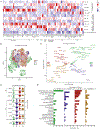Spatial transcriptomics reveals organized and distinct immune activation in cutaneous granulomatous disorders
- PMID: 39098508
- PMCID: PMC11560686
- DOI: 10.1016/j.jaci.2024.07.021
Spatial transcriptomics reveals organized and distinct immune activation in cutaneous granulomatous disorders
Abstract
Background: Noninfectious (inflammatory) cutaneous granulomatous disorders include cutaneous sarcoidosis (CS), granuloma annulare (GA), necrobiosis lipoidica (NL), and necrobiotic xanthogranuloma (NXG). These disorders share macrophage-predominant inflammation histologically, but the inflammatory architecture and the pattern of extracellular matrix alteration varies. The underlying molecular explanations for these differences remain unclear.
Objective: We sought to understand spatial gene expression characteristics in these disorders.
Methods: We performed spatial transcriptomics in cases of CS, GA, NL, and NXG to compare patterns of immune activation and other molecular features in a spatially resolved fashion.
Results: CS is characterized by a polarized, spatially organized type 1-predominant response with classical macrophage activation. GA is characterized by a mixed but spatially organized pattern of type 1 and type 2 polarization with both classical and alternative macrophage activation. NL showed concomitant activation of type 1, type 2, and type 3 immunity with a mixed pattern of macrophage activation. Activation of type 1 immunity was shared among, CS, GA, and NL and included upregulation of IL-32. NXG showed upregulation of CXCR4-CXCL12/14 chemokine signaling and exaggerated alternative macrophage polarization. Histologic alteration of extracellular matrix correlated with hypoxia and glycolysis programs and type 2 immune activation.
Conclusions: Inflammatory cutaneous granulomatous disorders show distinct and spatially organized immune activation that correlate with hallmark histologic changes.
Keywords: Sarcoidosis; granuloma annulare; granulomatous; necrobiosis; necrobiosis lipoidica; necrobiotic xanthogranuloma; spatial transcriptomics.
Copyright © 2024 American Academy of Allergy, Asthma & Immunology. Published by Elsevier Inc. All rights reserved.
Conflict of interest statement
Disclosure statement Supported by a K08 grant from the National Institute of Allergy and Infectious Diseases (K08AI159229 to W.D.). Disclosure of potential conflict of interest: B. E. Shields has served as a consultant for Arcutis Biotherapeutics. C. A. Nelson has received research support from Boehringer Ingelheim. W. Damsky has served as a consultant for Pfizer, Eli Lilly, TWI Biotechnology, Fresenius Kabi, Epiarx Diagnostics, Boehringer Ingelheim, CSL Behring, AbbVie, and Sanofi; has been provided research support from Pfizer, Advanced Cell Diagnostics/Bio-Techne, AbbVie, Bristol Myers Squibb, and Incyte; and receives licensing fees from EMD/Millipore/Sigma. The rest of the authors declare that they have no relevant conflicts of interest.
Figures







References
MeSH terms
Grants and funding
LinkOut - more resources
Full Text Sources
Medical

